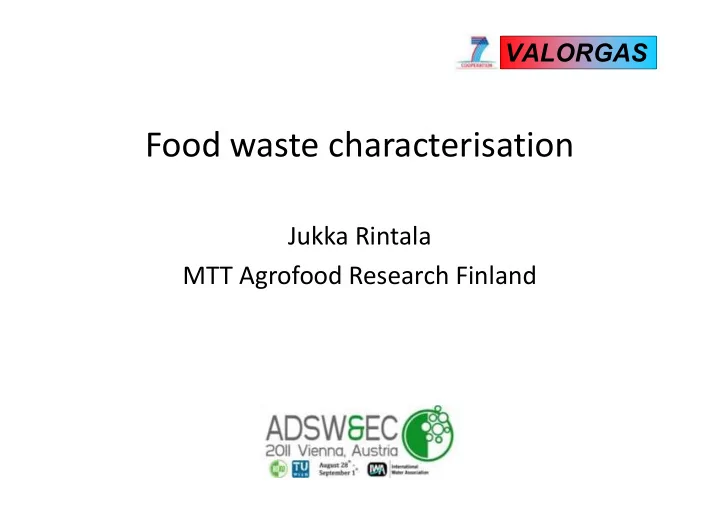

��������� Food waste characterisation Jukka Rintala MTT Agrofood Research Finland
��������� � Food waste – compositional analyses and characterisation HOW WHY � Waste composition � Waste prevention analyses � Avoidable � Kitchen diaries � Non avoidable � Potentially avoidable � Estimation from food � Waste treatment supply data � Waste system � Questionnaire surveys optimisation, including collection system � Design and operation of waste treatment process � Products from waste
��������� Food waste characterisation – � Composition analyses � Categorisation � Primary and sub-categories � Degradation � In waste container, during transport � Effects identification � Food packing � Pre-treatment � Sieving, removal of contaminants � Limitations � Variation � daily, seasonal, regional � Other routes for food waste � Residual waste, home composting, animal feed
��������� � Sorting
��������� � Sorting
��������� � Source segregated food waste, Finland 23.8.2011 16.3.2011 Item mass (g) proportion (%) mass (g) proportion (%) Fruit and vegetable waste 43500 20,97 % 22600 25,20 % Fruit and vegetables (whole) 10900 5,26 % 5698 6,35 % Pasta / rice / flour / cereals 1011 0,49 % 230 0,26 % Bread and bakery 5299 2,55 % 2428 2,71 % Meat and fish 3409 1,64 % 2421 2,70 % Bones 1977 0,95 % 327 0,36 % Dairy 233 0,11 % 362 0,40 % Egg shells 1612 0,78 % 890 0,99 % Drinks 56700 27,34 % 17489 19,50 % Confectionery and snacks 0 0,00 % 185 0,21 % Desserts 923 0,45 % 1857 2,07 % Condiments 230 0,11 % 0 0,00 % Mixed meals 11804 5,69 % 3985 4,44 % Other food 773 0,37 % 75 0,08 % Other food waste, identified but not s 4009 1,93 % 4992 5,57 % Biodegradable bags 9200 4,44 % 1453 1,62 % Contaminants 1369 0,66 % 1211 1,35 % Plastic containers 206 0,10 % 29 0,03 % Plastic bags 1627 0,78 % 153 0,17 % Paper and card 40200 19,38 % 15700 17,51 % Metals 43 0,02 % 3 0,00 % Glass 0 0,00 % 268 0,30 % Garden waste 9600 4,63 % 6475 7,22 % Miscellaneous 2776 1,34 % 843 0,94 % Total 207401 100,00 % 89674 100,00 %
��������� � Food waste composition �� � ���� � ������� �������� ����� ��� ������������ ������������������������� ���� ���� ���� ���� ���� ���� ������������������������ �� ��� ��� ��� !�� ��� "�����������#��$ ��� !�� !� ��� ��% !�� &������������� ��% ��! %�! ��� �� ��� '���$ �% ��� ��% �� �� !�� '���#��(���)�������** %� �%�� ��� ��� ��% ��� +�����������$)�����#����� ��% !�� ��! ��� �� �% &�,���-���� ��! ��! ���� �� ��� ��� .��������� ��� ��� ��� ��� !�� !�� /���� ���� ���� ���� ���� ���� ���� � � '�������-����������������������������������������� "���� ���012��
��������� � Comparison of results of food waste compositional analysis for samples from UK, Finland, Portugal and Italy. (Error bars show range).
��������� � Physico-chemical Characterisation of Food Waste Eastleigh, UK Forssa, FI Treviso, IT pH 5.7 5.34 6.16 TS, %WW 28.62±0.07 27.02±0.12 27.47±0.03 VS, %WW 26.83±0.16 24.91±0.05 23.60±0.09 VS, %TS 94.18±0.42 92.26±0.26 86.60±0.40 TKN, % TS 2.74±0.05 2.39±0.04 2.55±0.03 TKN, g Kg -1 WW 7.84±0.16 6.45±0.1 7.02±0.1 CV, KJ g -1 TS 21.32+±0.08 21.39±0.11 20.50±0.11 Lipids, gkg -1 VS 152.2±2 156±0.5 202±0.5 Crude protein, gkg - 183±4 162±0.4 186±3 1 VS TKN, gkg -1 TS 27.4±0.5 23.9±0.4 25.5±0.3 TP, gkg -1 TS 2.94±0.01 2.73±0.05 3.47±0.06 TK, gkg -1 TS 11.2±0.2 10.0±0.2 10.0±0.1
��������� � www.valorgas.soton.ac.uk Valorisation of food waste to biogas Project 241334 Sponsored by FP7 ENERGY.2009.3.2.2 Biowaste as feedstock for 2nd generation
Recommend
More recommend